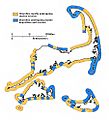Deposition (geology) facts for kids
Deposition is a natural process where geological materials like sand, mud, or rocks are added to a landform or a piece of land. Think of it like building up a new part of a beach or a riverbank. While some parts of a shoreline might wear away (this is called erosion), other parts grow bigger because of deposition.
This process happens when wind or water carry tiny bits of material, called sediment, and then drop them off in a new place. Imagine a river carrying sand. When the river slows down, it doesn't have enough energy to carry the sand anymore, so the sand settles to the bottom. This is deposition! It occurs when the forces moving the sediments become weaker than the weight of the particles and the friction holding them back. This causes the particles to stop moving and settle down.
Deposition can also happen when living things or chemical reactions create new material that builds up. For example, shells from sea creatures can pile up to form new land.
Contents
What is Deposition?
Deposition is a key part of how our planet's surface changes over time. It's the opposite of erosion, which is when material is worn away and carried off. Together, erosion and deposition constantly reshape Earth's landscape.
How Does Deposition Happen?
Deposition mainly occurs when the energy of the wind, water, or ice carrying sediments decreases.
- Water: Rivers drop sediments when they slow down, especially as they enter a lake or the ocean, forming deltas. Waves also deposit sand on beaches.
- Wind: Wind carries sand and dust. When the wind slows down or hits an obstacle, it drops the sand, creating sand dunes.
- Ice: Glaciers pick up rocks and soil as they move. When a glacier melts, it leaves behind all the material it was carrying, forming features like moraines.
Where Does Deposition Occur?
Deposition creates many different landforms around the world.
- Beaches: Sand is deposited by waves and currents.
- River Deltas: These are triangular landforms created at the mouth of a river where it flows into a larger body of water, like an ocean or lake. The river slows down and drops its sediment.
- Sand Dunes: Formed in deserts or coastal areas by wind depositing sand.
- Alluvial Fans: Cone-shaped deposits of sediment formed where a fast-flowing river leaves a mountain range and enters a flatter plain.
- Floodplains: Flat areas next to rivers that are created when the river overflows its banks and deposits sediment during a flood.
Types of Deposition
Besides the dropping of eroded sediments, deposition can also involve other processes:
- Organic Deposition: This happens when materials from living things build up. For example, the remains of plants and animals can form layers that eventually become fossil fuels like coal or oil. Coral reefs are also built through organic deposition by tiny marine animals.
- Chemical Deposition: This occurs when dissolved minerals in water come out of solution and settle as solid material. For instance, stalactites and stalagmites in caves are formed by the chemical deposition of calcium carbonate.
Images for kids
-
Map of Cape Cod showing shores undergoing erosion (cliffed sections) in yellow, and shores characterized by marine deposition (barriers) in blue.
-
Figure 2. This map of Akaroa Harbour shows that the sediments get finer (smaller) as you move toward the deeper, central part of the harbour. This means the heavier, coarser sediments are closer to the edges, and the lighter, finer sediments are carried further out and deposited in the calmer, deeper water.
Related Pages
See also
 In Spanish: Deposición (geología) para niños
In Spanish: Deposición (geología) para niños



